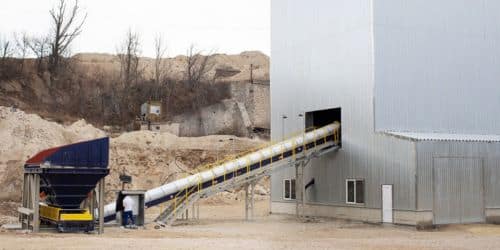Have you ever wondered where all that road salt comes from when winter storms hit? Those huge piles of salt sitting by the highway have to be stored somewhere before they get spread on the streets. Bulk salt storage buildings play an important role in keeping salt dry and ready for winter weather.
Walk through what these structures are all about. This article will explain who needs them, what goes on inside, and how to choose the right building for your needs.
Overview of Bulk Salt and Why Proper Storage is Critical
Salt is a big deal in cold climates. It lowers the freezing point of water, causing ice to melt. This makes winter travel safer. Bulk quantities of salt are used on roads, parking lots, sidewalks – anywhere icing is a problem. Of course, salt has many other uses too, like food production, water treatment, livestock health, and making chemicals.
Properly storing tons of salt is critical. If left exposed to rain and snow, it can become a useless, lumpy mess. Special storage buildings protect bulk salt from the elements so it’s ready to work when needed. One industrial salt storage expert explains all the purposes in detail on their site. Now look at the key features these buildings need…
Types of Organizations That Require Bulk Salt Storage
Public Works Departments
Public works departments use bulk quantities of road salt to deice roads during winter. A sufficient supply must be stored to last the entire snow season. Shortages can jeopardize public safety.
Environmental regulations require contained salt storage to prevent runoff into streams and groundwater. Salt buildings protect stockpiles from wind, rain, and snow.
Food Production Facilities
Food manufacturers use salt for flavoring, curing meats, and food preservation. Food-grade salt must be stored in dedicated facilities to prevent contamination. Quality storage maintains purity.
Chemical and Industrial Facilities
Bulk salt is used in chemical production, oil drilling, iron smelting, tanning, and wastewater treatment. Dedicated storage keeps industrial salt dry and separated for manufacturing processes.
Available Bulk Salt Storage Facility Options
Permanent Structures
Permanent buildings provide the most secure storage and longest lifespan. You understand different types of warehousing, salt storage is another type of facility that’s all. Popular types include:
- Steel arch: pre-engineered and pre-fabricated for fast construction. Sturdy and corrosion-resistant.
- Fabric – Made of engineered fabric over a steel or aluminum frame. More affordable than steel. Allows natural light.
- Wood – Typically a laminated wood arch or timber dome style. Low cost but higher maintenance.
- Concrete – Poured concrete walls and roof. Excellent durability but higher upfront cost.
Temporary Structures
For short-term needs, temporary structures work well:
- Salt domes – Canvas-covered hoop buildings assembled onsite. More economical.
- Poly structures – Polyethylene fabric stretched over a pipe frame. Quick setup but less durable.
Open Air Storage
Lowest cost but provides the least protection:
- Paved pads – Stores salt in the open on an impermeable concrete or asphalt pad. I Need a cover.
- Covered piles – Salt mounded outdoors and covered with tarps or polyethylene sheets. Requires tie-downs.
Choosing the Right Builder for Your Salt Storage Needs
Selecting the right vendor ensures you get the best value storage building. Here’s what to look for:
Experience – Look for an established company with proven expertise in salt storage construction.
Reputation – Check reviews and talk to past clients. Good word of mouth is a positive sign.
Offerings – See if they offer different structure types, sizes and materials to meet your needs.
Cost – Get quotes from multiple vendors and compare costs for the same specifications.
Ask prospective builders key questions like:
- How long have you been in business?
- Can I see examples of your previous salt storage projects?
- What types of structures and options do you offer?
- What is the typical project timeline?
- What warranties do you provide?
This helps verify they are qualified and can deliver on schedule.
Maintaining and Optimizing Your Salt Storage Facility
Take steps to maximize your investment and keep your salt building working optimally:
Inspect Annually – Check for wear, corrosion, leaks, damage and needed repairs. Address issues promptly.
Good Housekeeping – Keep the interior clean and organized for efficient handling. Remove debris regularly. There are essential storage products for materials in all businesses. Choose the correct ones, and keep them clean.
Optimize Storage – Maximize capacity by carefully stacking. Prevent contamination from foreign material.
Proper maintenance extends the structure’s lifespan and functionality.
Special Considerations for Road Salt Storage
Road salt contains minerals and sediments that can accumulate at the bottom of the stockpile. Proper drainage in your salt dome prevents standing water. Otherwise, salt can harden into clumps that no longer flow freely. Install drainage trenches that route runoff away from the mineral buildup.
Prevent Tracking
Salt clings to tires and equipment and gets tracked out of the storage facility. This causes loss of usable product and environmental issues. Designate specific entrances/exits and install mud mats to dislodge clinging material. Keep the access area clear of accumulated salt spills or puddles.
Sheltered Loading Area
Providing covered loading space allows year-round filling without weather interference. A canopy, overhang or extended roof protects the loading zone from rain and snow. This improves efficiency and safety for workers.
Wash Stations
Designate wash areas to regularly clean salt residue off trucks, loaders and other equipment. Contain wastewater for proper disposal or recycling. Keeping equipment clean extends its lifespan and prevents corrosion damage.
Specialized Coatings
Salt’s corrosive effects can damage building floors. Use heavy-duty urethane, epoxy or chemical-resistant coatings formulated for salt environments. Re-apply regularly to maintain protection. Choose light colors to better spot potential leaks.
Separate Bulk and Bagged Storage
Many agencies stock bagged salt for smaller jobs. Storing bulk and bagged products together can cause bag deterioration. Maintain separate compartmentalized space for bulk stockpiles and palletized bagged products.
Ideas to Optimize Your Current Salt Storage
Add Interior Lighting Proper lighting improves visibility and safety when working inside the structure. It also aids monitoring and inspection. Choose moisture-resistant fixtures positioned to avoid salt corrosion.
Improve Ventilation
Humidity causes salt to clump together. Ensure adequate airflow using circulation fans, roof ventilators, or opening side panels. Monitor interior conditions.
Upgrade Access Points Widen doorways or access points that are too narrow for equipment. Increase vertical clearance if needed. Improve traffic flow for loading operations.
Expand Capacity
As usage grows over time, expand the footprint of your current building if feasible. Adding adjacent space may be more affordable than an entirely new structure.
Implement Inventory System
An inventory system tracks current stock levels and notifies when supply is low. This prevents shortages and ensures timely reordering. Barcode scanning streamlines monitoring.
Incorporate Solar Power
Solar panels reduce reliance on the grid while providing renewable power. Look for high-efficiency panels that perform even in low, wintry light conditions.
These enhancements improve efficiency, space utilization, safety and sustainability. With some creativity, existing buildings can gain more functionality.
Summary
Bulk salt storage buildings are an indispensable tool for organizations that rely on large quantities of salt. Permanent structures provide ideal protection for stockpiles against the elements.
Careful design and working with an experienced builder ensures your facility meets your specific needs. Proper maintenance keeps it functioning optimally for years of service. Knowing what type of salt building is right for your purposes will pay dividends in cost savings and supply readiness.






